People are drawn to beauty, even in the harshest of places. And when we are drawn to beauty we are drawn to each other.
By Maureen Wilson
Published January 19, 2018
"Beauty has long since disappeared. It has slipped beneath the surface of the noise, the noise of words, sunk deep as Atlantis. The only thing left of it is the word, whose meaning loses clarity from year to year." —Milan Kundera
What is it you see when first entering your city?
If you enter off York Boulevard or Plains Road in Hamilton, you see what ambition used to look like. Yes, it was a vision of industry and enterprise. But to be an ambitious city was also to be a beautiful city. And nowhere was beauty more revered than in the public sphere. Our public works, public schools, our hospitals, libraries and public spaces were designed to inspire and to serve as examples of what could and should be built.
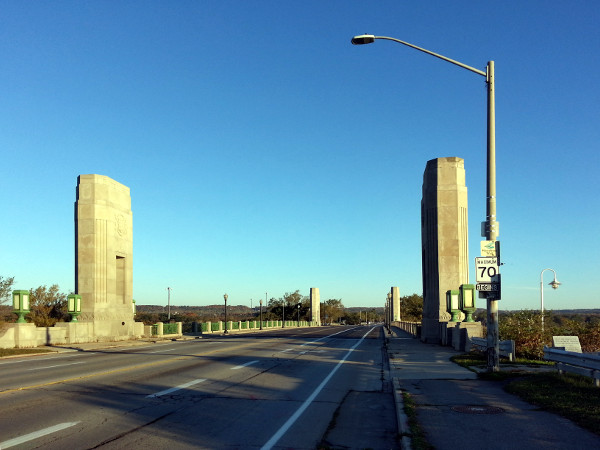
McQuesten High Level Bridge (RTH file photo)
Beauty is critical to successful city building. Because beauty is hope. When you enable hope, you can galvanize confidence and propel futures. It is the stuff of legacy making.
People are drawn to beauty, even in the harshest of places. And when we are drawn to beauty we are drawn to each other. Connectivity is critical to building and sustaining healthy cities. Connections can lead to understanding, understanding to empathy and support for action beyond the immediate and the self.
By giving primacy to beauty, an ambitious city can help lift and equalize our expectations of public spaces, and, by extension, the people and neighbourhoods in and around those spaces.
By giving primacy to beauty in our public spaces, we are insisting that all citizens are worthy of beauty.
In Hamilton, we allowed ourselves to be convinced that as our city's economic fortunes dwindled, we could no longer afford beauty. We soon felt unworthy of beauty and stopped insisting on beauty. Our built form collapsed to meet our expectations.
In retreating from beauty, we handed responsibility for and the requirements of beauty to market forces. Beauty became a measure of means: the ability to pay. As our means slipped and became more segregated across the city, so did beauty.
The guardians of beauty - city government, boards of education, the hospital and social service sectors - retreated from their duty of leading with beauty and maintaining that which was beautiful. In so doing, they removed a key arsenal of city building and civic engagement and they precipitated the segregation of beauty.
Many of our public schools started to look like our public housing. Litter, graffiti, limited natural light, fake grass, no trees, unclean washrooms, dumpsters, neon drive-by signs, mold-infested portables and death-defying crossings reflects the value we have ascribed to public education and its role as the great equalizer.
Our public housing was designed to be punitive, absent of light and a constant reminder of low expectations and extinguished hope. We let our public housing stock rot.
Public washrooms became extinct. Public works became disposable. Trees became puny and gentle giants have been left to suffer the wrath of extreme cold, unforgiving heat and impermeable surfaces.
Rather than honouring and adding value to surrounding neighbourhoods, our hospitals became adorned with severe lighting, oversized fundraising banners, an insatiable appetite for more parking, and a design that is incongruent with and hostile to the surrounding neighbourhoods.
Main Street marks the death of the boulevard and the idea of shared public space. There are few people in sight. Conversation is impossible, laughter undetectable due to the sound of five lanes of cars and trucks racing through the heart of our city.
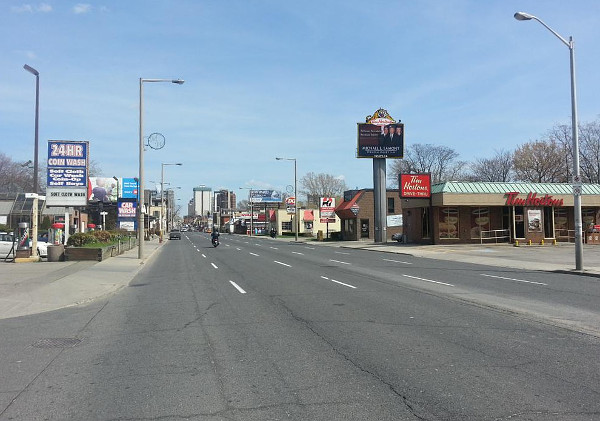
Main Street West (RTH file photo)
There is no room for sauntering, no allowance for safety, no greenery for shade. There is only the noise of words - the realtor's, the personal injury lawyer's, Tim Horton's - set at a height intended for those not interested in stopping, shopping and taking up residence.
It is any wonder that businesses along these routes have suffered, along with the neighbourhoods? Regrettably, this is a scene replicated across too many parts of our city.
Educator and artist Bill Strickland of Pittsburgh has been celebrated around the world for his success in creating opportunity for the forgotten and the displaced and for his insistence on beauty when doing it. Principals, planners, police and private sector leaders visit his now-famous vocational school, set in the poorest, most crime-ridden area of Pittsburgh. His successful college placement rates (90 percent) are the envy of any school administrator.
At speaking engagements, he does not arrive with a prepared text but a box of slides. Because in his case, pictures do tell a thousand words. The slides offer exquisite exterior and interior shots of his school and are evidence of his deliberate insistence on beauty and his belief in the transformative power of beauty in altering human behaviour.
After touring the buildings and the grounds, leaders from around the world always stop to ask Strickland: "How did you manage to get and keep these beautiful orchids in the hallways?" Strickland's answer is always the same: "I got into my car. Drove to the store and bought them."
Beauty, it would seem, has become an anomaly in our poorest places and our schools.
Strickland explains that the students need to be know that their world can be made up of orchids, that they are deserving of orchids and that they have a responsibility in caring for orchids. They are, after all, citizens and stewards.
Neuroscientists are just starting to study the science of beauty and our brains. Evidence to date suggests that beauty motivates us and has a powerful impact on our health and well being. (Nancy Etcoff, cognitive scientist, Harvard Medical School, Survival of the Prettiest: The Science of Beauty; Are We Hard Wired for Beauty, Dutton and Etcoff, NPR).
There are many studies showing that hospitalized patients with views of nature and its greenery recover faster and are able to leave hospital sooner than those left staring at walls.
The late philosopher Denis Dutton played the role of disruptor when he first offered up a Darwinian theory of beauty, combining art and evolutionary science. His work around the globe led him to conclude that the very survival of the human race is dependent on experiencing beauty.
He argued that our love of beauty and our need for beauty was not determined by our surroundings but by the skills and rich emotional lives of our ancient ancestors. (Denis Dutton, The Art Instinct: Beauty, Pleasure and Human Evolution, 2009).

cave painting of a hyena from 30,000 years ago (Image Credit: Carla Hufstedler/Flickr, CC BY-SA 2.0)
An affinity for beauty is cross cultural, multi generational, not dependent on income and that which is universal should be universally available.
Fortunately, there are signs of beauty's revival in Hamilton. There have been steadfast champions who rarely wavered in their demand and delivery of beauty. They have been joined more recently by a new batch of local developers and architects who insist on beauty, aware of legacy. Take a walk down King William Street in Hamilton to see what I mean, or take a look at some of the social housing being built by Indwell.
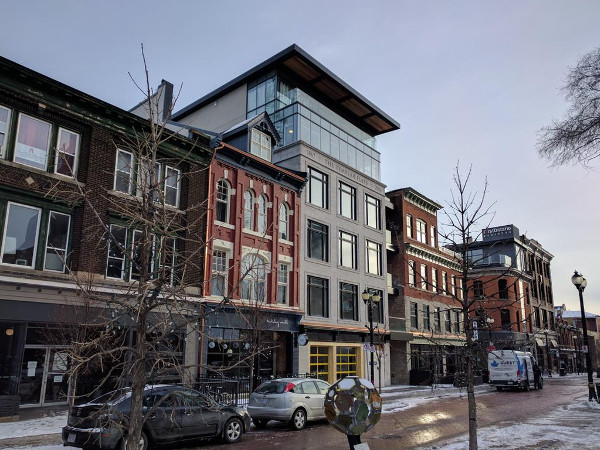
Templar Flats on King William (RTH file photo)
Will our public spaces follow the lead of those who understand the many returns that beauty offers?
Perhaps it should come as no surprise that the revival of beauty in public space is being led by Hamilton's library service. Maybe it is because libraries take their cue from the simple beauty of the written word, or perhaps it stems from their mission of public service. Most residents get a library card at an early age before they receive a driver's license or passport. In fact, citizenship is inconsequential to service.
Their leadership in beauty might reflect a keen sense that they must continuously remain relevant in their city and their neighbourhoods. Our libraries are evolving and thriving even with the onset of the digital age, even while independent bookstores are being shuttered and superstores like Chapters move further away from books and closer to lifestyle and lattes.
If Hamilton is enjoying a renaissance and a rebuild, I hope that my city feels strong enough to demand what it deserves - a return to beauty - so that all of its parts are made to feel whole.
You're on the road
But you've got no destination
You're in the mud
In the maze of her imagination
You love this town
Even if that doesn't ring true
You've been all over
And it's been all over you
It's a beautiful day
Don't let it get away
It's a beautiful day
— U2, "Beautiful Day"
Here are just a few examples of how we have strayed from beauty in our public spaces These photographs are taken primarily from my neighbourhood Kirdendall, in Hamilton.
The late Stanley Roscoe served as Canada's first city architect (1951-60) in Hamilton. He designed this modernist public washroom at the west end of the Chedoke Municipal Golf Course. This is how it is honoured today.
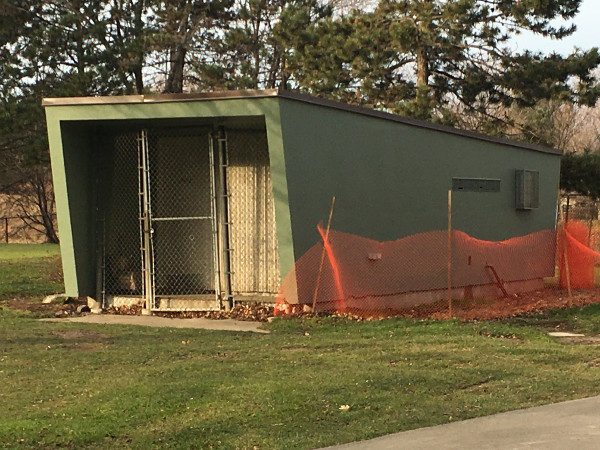
Roscoe Public Washroom
A number of years ago the Chedoke Municipal club house served as a substitute for a dilapitated Guatemalan hospital in a movie shoot. Few trail and stair users are aware that the club house is open to the public and it remains under utilized by intent.
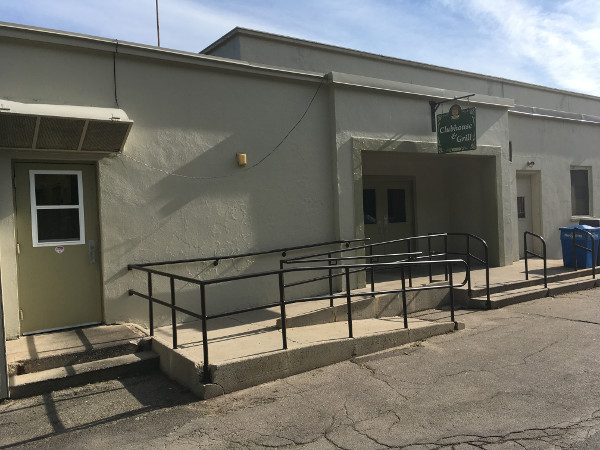
Chedoke Club House
This is a public washroom at the north end of the Chedoke Municipal Golf Course. The unfinished paint job is longstanding. It closes at the end of the golfing season despite the many trail and course walkers all year round.
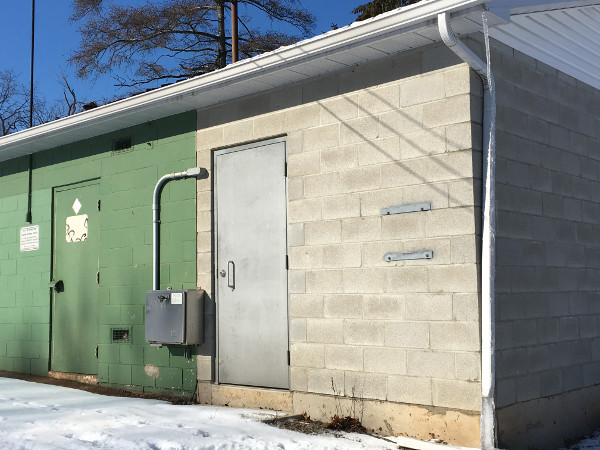
Chedoke Washroom
The municipally owned Highland Gardens consists of two green spaces. The one up top houses an underground reservoir which has been under construction for many years. The entire park used to be serviced by a public gardener and the top section once had a magnificent garden. The gardens and the gardener are long gone. The double set of stairs at the top of Mountain Avenue, where generations of Kirkendall residents would stop, sit, think and chat has been replaced with a single metal set of stairs. Don't try sitting on it.
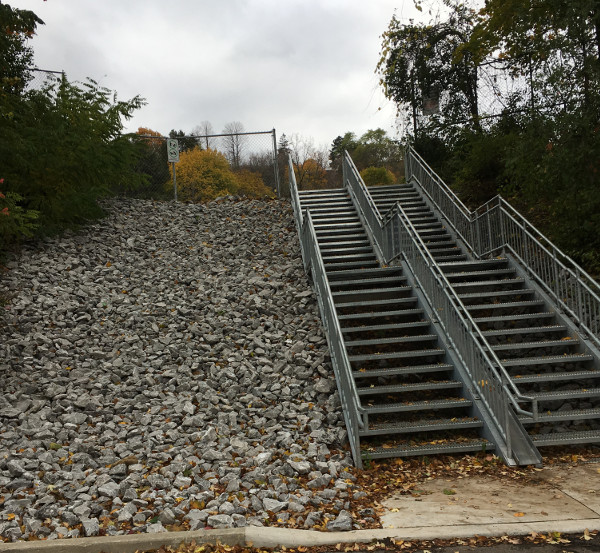
Highland Gardens staircase
This staircase might be considered a beautiful public work. In Siberia.
The shed at Mapleside Park was replaced with a new shed. The neighbours suggested that the replacement be adorned with simple railroad fixtures to reflect the history of the site. The Brantford and Hamilton electric railway played an important role in the city's development in the early 1900s before being abandoned in the 1930s. The radial line ran through the site where the park now resides.
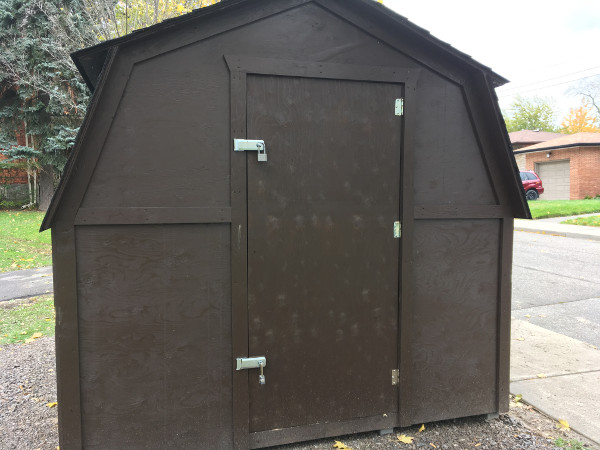
Ted the Shed, Mapleside Park
They also suggested that the electrical outlet be set within the shed. Instead, it was once again attached to a rotting wooden post.
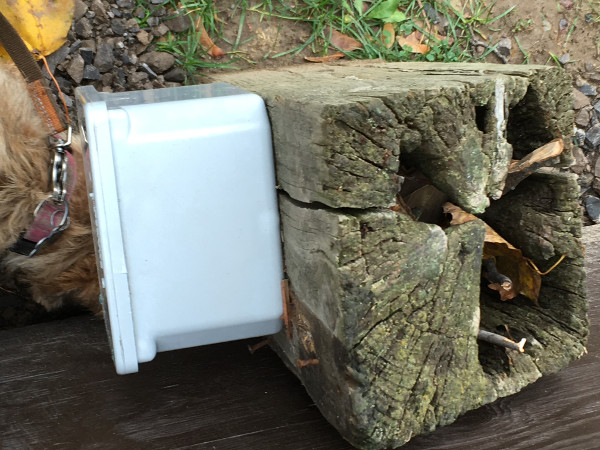
Electrical outlet
Giant signs adorned with bright lights to get the attention of drivers while shouting at neighbours.
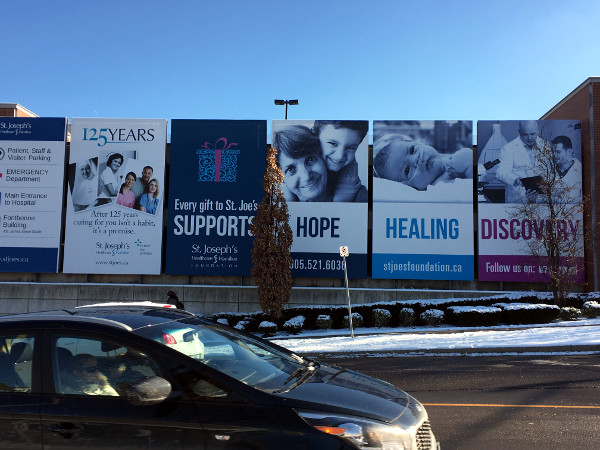
St. Joseph's Hospital signs
The hospital demolished a brick building and put up a temporary trailer many years ago. It's still there. Nothing says we value a neighbourhood like a trailer at a key intersection.
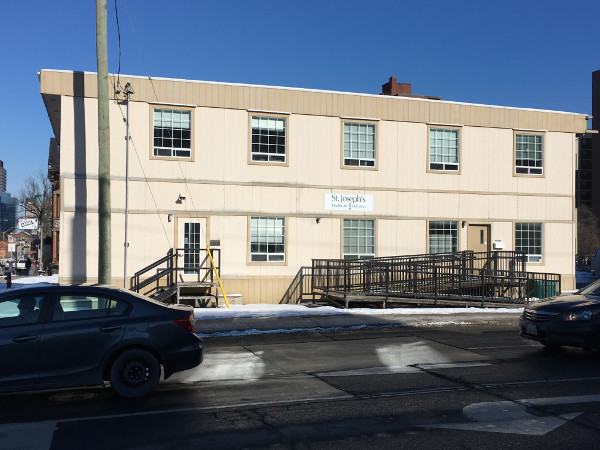
St. Joseph's Trailer, James Street South and Charlton Street East
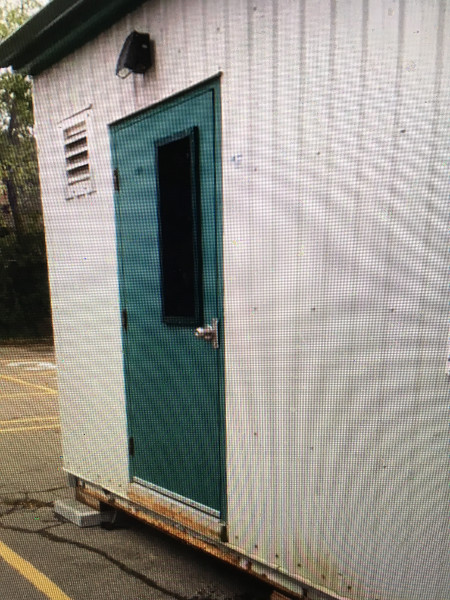
Earl Kitchener School portable
By kevlahan (registered) | Posted January 20, 2018 at 15:22:59
Thanks for this thoughtful piece on the importance of design and high quality public amenities.
The building demolished by St Joseph's hospital was actually a rare stone townhouse built in 1855 as the home of banker Henry Titus. It was demolished in 2007 for no other reason than the hospital was worried that it could be designated and interfere with unspecified future development plans (they made the usual excuse that the hospital 'can't afford to fix it' and they wanted the space for future expansion).
Note that the demolition didn't actually provide any more space for the hospital since the portable was simply moved from another location further South on James St!
https://www.thespec.com/news-story/21381...
The fact that a significant heritage building was pre-emptively demolished and 11 years later the spot is still occupied by an ugly portable shows an appalling lack of respect for its neighbourhood by a powerful and wealthy stakeholder.
As a speaker in McMaster's city conference series pointed out last year, public or largely publicly funded institutions like schools, hospitals and universities have special privileges and special duties to the community by virtue of their resources and ability to take a long term view.
http://bigideasbettercities.mcmaster.ca/
Surely St Joseph's could have found something better to do with the building than demolish it and replace it long term with an ugly portable on a very prominent intersection!
Here's the view of the two storey portable from James St: no windows: just an unusable door on the second floor!
https://www.google.ca/maps/@43.2500346,-79.8720547,3a,75y,107.71h,84.06t/data=!3m6!1e1!3m4!1s5rsA24-YHfPBRMn_CGv-Pg!2e0!7i13312!8i6656
Comment edited by kevlahan on 2018-01-20 15:26:07
By fmurray (registered) | Posted January 21, 2018 at 11:21:29 in reply to Comment 122347
I agree, Nicholas and Maureen. That building in particular makes me think swear words every time I see it.
By Janice (registered) | Posted January 21, 2018 at 12:48:29
Thank you Maureen. And I agree with Bill Strickland that a picture is worth a thousand words. As most of your photos are in Wards 1 and 2, I do hope that our Councillors have seen this. Our City at least should be leading by example!
But also to end on a positive comment, thank you for introducing me to Bill Strickland and his TED talk! Inspiring to say the least!
By TreyS (registered) | Posted January 27, 2018 at 12:06:47
What an awesome piece. Thanks for this.
Love this "Maybe it is because libraries take their cue from the simple beauty of the written word, or perhaps it stems from their mission of public service. "
So true about public washrooms. Gore Park had underground washrooms. I suspect it was too much effort to maintain for the city. The new public washrooms are in a private Tim Hortons. And what's with Jackson Sq washrooms? How long will they be closed?
You must be logged in to comment.
There are no upcoming events right now.
Why not post one?